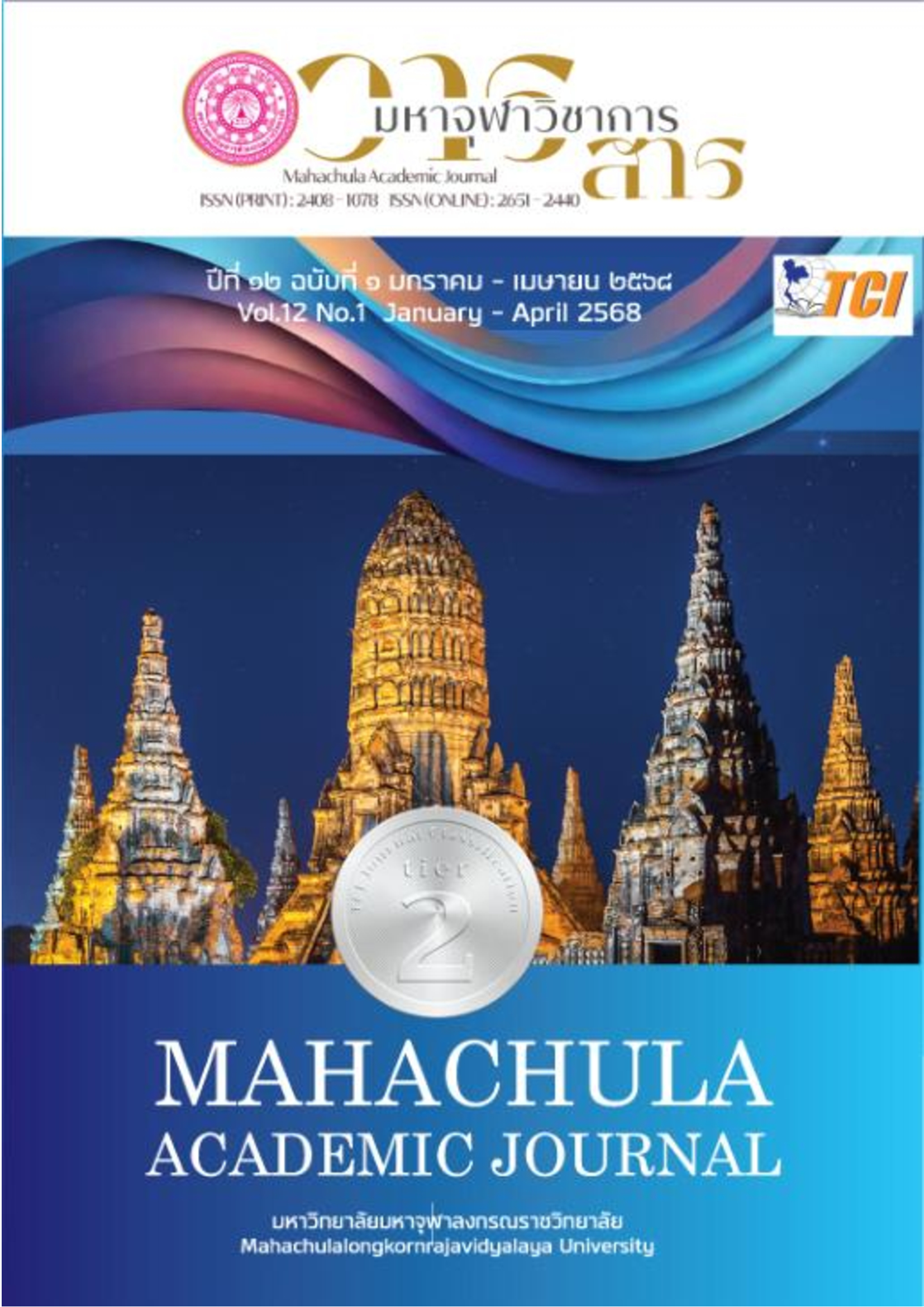An Analytical Study of Happiness in Living Life according to the Sukha Sutta
Main Article Content
Abstract
In This research, three objectives were purposely made: (1) to study happiness in Buddhist scriptures, (2) to study happiness in the Sukha Sutta, and (3) to analytically study happiness in living according to the Sukha Sutta. This documentary research studies Tipitaka, its commentaries, and related documents.
The results showed that happiness in Buddhism basically means physical and mental happiness, embracing a sense of ease and satisfaction from experiencing desirable and pleasing emotions through the eyes, ears, nose, tongue, body, and mind. Happiness comprises four levels: (1) kãmã-sukha, (2) jhãnã-sukkha, (3) nirodhasamãpatti-sukha, and (4) Nibbãna-sukkha. Sensual happiness is for ordinary people and is considered inferior. jhãnã-sukkha and nirodhasamãpatti-sukha are superior. Nibbãna-sukkha is the ultimate happiness, surpassing all other forms, embodying peace and utmost refinement. The happiness in the Sukha Sutta can be classified into the five Suttas: (1) Sukha Sutta, (2) Pathama Sukha Sutta, (3) Dutiya Sukha Sutta, (4) Sukapatthanã Sutta, and (5) Sukhasomanassa Sutta. These suttas guide practitioners to attain happiness by relinquishing attachment to sensory experiences, understanding the arising of suffering, taking joy in happiness, upholding moral discipline, associating with good people, and delighting in the six aspects of the Dhamma: 1) the Dhamma, 2) meditation, 3) renunciation, 4) solitude, 5) non-ill will, and 6) non-procrastination. Among these five Suttas, Sukapatthanã Sutta provides worldly happiness for laypeople, while the other Suttas provide supramundane happiness for the ordained. Happiness in living life of laypeople includes financial stability, having an honest profession, having a good reputation, associating with good friends, giving to others, contentment, constantly observing the Five or Eight Precepts, cultivating kindness, and practicing mindfulness through meditation. For the ordained, happiness includes upholding the Dhamma-Vinaya, maintaining restraint in body and speech, engaging in meditation, cultivating mindfulness at all times, living a life of few desires and contentment, realizing the impermanence of all things, letting go of attachment, and training oneself to eradicate defilements to attain Nibbãna. These practices lead to a happy and sustainable life according to the principles of the Sukha Sutta.
Article Details

This work is licensed under a Creative Commons Attribution-NonCommercial-NoDerivatives 4.0 International License.
References
จักรพงษ์ ทิพสูงเนิน เเละคณะ. “วิธีการสร้างความสุขตามหลักพุทธปรัชญา”. วารสารรัฐศาสตร์ มหาวิทยาลัยราชภัฏสวนสุนันปทา. ปีที่ ๖ ฉบับที่ ๑ (มกราคม-มิถุนายน ๒๕๖๖): ๘๐-๘๑.
ณัฏฐาพรรณ กรรภิรมย์พชิรา. “การศึกษาวิเคราะหสุขวรรคในคัมภีร์ธรรมบท”. วิทยานิพนธ์. บัณฑิตวิทยาลัย: มหาวิทยาลัยมหาจุฬาลงกรณวิทยาลัย, ๒๕๖๔.
ทรงวิทย์ ปลัดศรี. “ความสุขในมรรค ๘”. วารสารเสฏฐวิทย์ปริทัศน์. ปีที่ ๑ ฉบับที่ ๑ (มกราคม-เมษายน ๒๕๖๔): ๖๑.
นนทิวัต ไล้เลิศ. “การเสริมสร้างความสุขในบริบทของการปฏิบัติธรรมตามเเนวมหาสติปัฏฐานสูตร”. วารสารสังคมศาตร์เเละมานุษยวิทยาเชิงพุทธ. ปีที่ ๕ ฉบับที่ ๕ (พฤษภาคม ๒๕๖๓): ๒๖๔-๒๖๗, ๒๗๒.
ปราโมทย์ ยอดเเก้ว. “ความรู้: การพัฒนาความสุขเเห่งโลกความจริง”. วารสารครุศาสตร์ปริทรรศน์ คณะครุศาสตร์ มหาวิทยาลัยมหาจุฬาลงกรณราชวิทยาลัย. ปีที่ ๓ ฉบับที่ ๑ (มกราคม-เมษายน ๒๕๕๙): ๑๖, ๑๙.
พระมหาคมสัน วิสุทฺธิญาโณ. “วิธีปฏิบัติเพื่อให้เข้าถึงความสุขตามหลักพระพุทธศาสนา”. วารสารสันติศึกษาปริทรรศน์ มจร. ปีที่ ๗ ฉบับที่ ๑ (มกราคม-กุมภาพันธ์ ๒๕๖๒): ๒๙-๓๐.
พระมหาปัญญาวรวัฒน์ สิรภทฺโท. “ชีวิตมีความสุขต้องมีศีล ๕”. สารนิพนธ์พุทธศาสตรบัณฑิต. บัณฑิตวิทยาลัย: มหาวิทยาลัยมหาจุฬาลงกรณราชวิทยาลัย, ๒๕๖๐.
พระมหาวิเชียร สุธีโร. “ความสุขในทัศนะของพระพุทธศาสนา”. วารสารพุทธมัคค์ ศูนย์วิจัยธรรมศึกษา สำนักเรียนวัดอาวุธวิกสิตาราม. ปีที่ ๔ ฉบับที่ ๑ (มกราคม-มิถุนายน ๒๕๖๒): ๔๒-๔๗.
พระมหาสุทิตย์ อาภากโร (อบอุ่น) และคณะ. “การสร้างและพัฒนาตัวชี้วัดความสุขของประชาชนตามหลักคำสอนของพระพุทธศาสนา”. รายงานวิจัย. สถาบันวิจัยพุทธศาสตร์: มหาวิทยาลัยมหาจุฬาลงกรณวิทยาลัย, ๒๕๕๘.
มหาจุฬาลงกรณราชวิทยาลัย. พระไตรปิฎกภาษาไทย ฉบับมหาจุฬาลงกรณราชวิทยาลัย. กรุงเทพมหานคร: โรงพิมพ์มหาจุฬาลงกรณราชวิทยาลัย, ๒๕๓๙.
มหาจุฬาลงกรณราชวิทยาลัย. อรรถกถาภาษาไทย ฉบับมหาจุฬาลงกรณราชวิทยาลัย. กรุงเทพมหานคร: โรงพิมพ์มหาจุฬาลงกรณราชวิทยาลัย, ๒๕๕๙.
สมเด็จพระพุทธโฆษาจารย์ (ป. อ. ปยุตฺโต). พจนานุกรมพุทธศาสน์ ฉบับประมวลศัพท์. พิมพ์ครั้งที่ ๓๑. กรุงเทพฯ: บริษัท สหธรรมิก จำกัด, ๒๕๖๑.
ธีระพล เต็มอุดม. “ไทยปลื้ม” ดัชนีความสุข ปี 67 ขึ้นอันดับ 60 มุ่งสร้างสังคมสุขภาวะทางปัญญาอย่างยั่งยืน. [ออนไลน์]. แหล่งที่มา: https://www.hfocus.org/content/2024/03/30015 [๒ ตุลาคม ๒๕๖๗].


